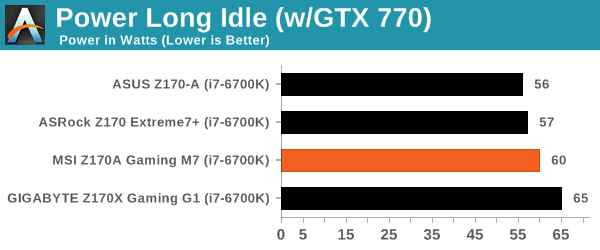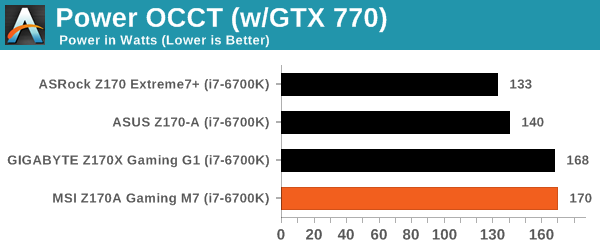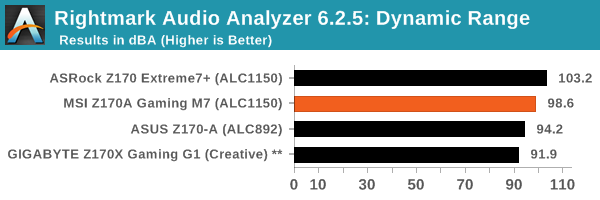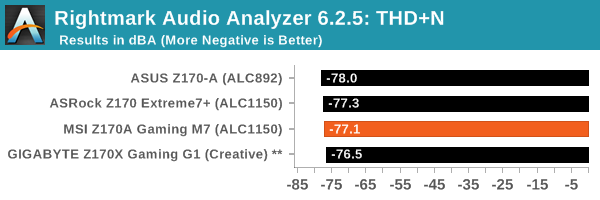The MSI Z170A Gaming M7 Review: The Step Up to Skylake
by Ian Cutress on September 21, 2015 12:30 PM EST- Posted in
- Motherboards
- Gaming
- MSI
- Skylake
- Z170
System Performance
Not all motherboards are created equal. On the face of it, they should all perform the same and differ only in the functionality they provide - however this is not the case. The obvious pointers are power consumption, but also the ability for the manufacturer to optimize USB speed, audio quality (based on audio codec), POST time and latency. This can come down to manufacturing process and prowess, so these are tested.
Power Consumption
Power consumption was tested on the system while in a single MSI GTX 770 Lightning GPU configuration with a wall meter connected to the OCZ 1250W power supply. This power supply is Gold rated, and as I am in the UK on a 230-240 V supply, leads to ~75% efficiency > 50W, and 90%+ efficiency at 250W, suitable for both idle and multi-GPU loading. This method of power reading allows us to compare the power management of the UEFI and the board to supply components with power under load, and includes typical PSU losses due to efficiency. These are the real world values that consumers may expect from a typical system (minus the monitor) using this motherboard.
While this method for power measurement may not be ideal, and you feel these numbers are not representative due to the high wattage power supply being used (we use the same PSU to remain consistent over a series of reviews, and the fact that some boards on our test bed get tested with three or four high powered GPUs), the important point to take away is the relationship between the numbers. These boards are all under the same conditions, and thus the differences between them should be easy to spot.



The MSI comes in on the latter end of our power testing, which might be related to the early BIOS used at the time of testing as well as the implementation of MultiCore Turbo similar to the Gaming G1. We did note that these early BIOSes do tend to implement a high stock voltage under load as well.
Windows 7 POST Time
Different motherboards have different POST sequences before an operating system is initialized. A lot of this is dependent on the board itself, and POST boot time is determined by the controllers on board (and the sequence of how those extras are organized). As part of our testing, we look at the POST Boot Time using a stopwatch. This is the time from pressing the ON button on the computer to when Windows 7 starts loading. (We discount Windows loading as it is highly variable given Windows specific features.)

Similarly, the early BIOS versions are unlikely to be optimised for POST. In this circumstance, a stripped BIOS caused some issues that exacerbated the POST time.
Rightmark Audio Analyzer 6.2.5
Rightmark:AA indicates how well the sound system is built and isolated from electrical interference (either internally or externally). For this test we connect the Line Out to the Line In using a short six inch 3.5mm to 3.5mm high-quality jack, turn the OS speaker volume to 100%, and run the Rightmark default test suite at 192 kHz, 24-bit. The OS is tuned to 192 kHz/24-bit input and output, and the Line-In volume is adjusted until we have the best RMAA value in the mini-pretest. We look specifically at the Dynamic Range of the audio codec used on board, as well as the Total Harmonic Distortion + Noise.


From the outset it seems that we will have a range of audio codecs being used on Z170, especially when each of the main manufacturers might have some additional software enhancements over the top. For example, the Creative featureset of the G1 can never be fully turned off, making a hardware analysis of the audio output difficult to the extent of being semi-meaningless. I fear this will only get more difficult as time goes on.
USB Backup
For this benchmark, we transfer a set size of files from the SSD to the USB drive using DiskBench, which monitors the time taken to transfer. The files transferred are a 1.52 GB set of 2867 files across 320 folders – 95% of these files are small typical website files, and the rest (90% of the size) are small 30 second HD videos. In an update to pre-Z87 testing, we also run MaxCPU to load up one of the threads during the test which improves general performance up to 15% by causing all the internal pathways to run at full speed.
Due to the introduction of USB 3.1, as of June 2015 we are adjusting our test to use a dual mSATA USB 3.1 Type-C device which should be capable of saturating both USB 3.0 and USB 3.1 connections. We still use the same data set as before, but now use the new device. Results are shown as seconds taken to complete the data transfer.

USB 3.0 (or USB 3.1 at 5 Gbps) is provided by the chipset/PCH, meaning we should see some consistency there, but the USB 3.1 at 10 Gbps can either be supplied by ASMedia or Intel, which might produce a spread of results.
DPC Latency
Deferred Procedure Call latency is a way in which Windows handles interrupt servicing. In order to wait for a processor to acknowledge the request, the system will queue all interrupt requests by priority. Critical interrupts will be handled as soon as possible, whereas lesser priority requests such as audio will be further down the line. If the audio device requires data, it will have to wait until the request is processed before the buffer is filled.
If the device drivers of higher priority components in a system are poorly implemented, this can cause delays in request scheduling and process time. This can lead to an empty audio buffer and characteristic audible pauses, pops and clicks. The DPC latency checker measures how much time is taken processing DPCs from driver invocation. The lower the value will result in better audio transfer at smaller buffer sizes. Results are measured in microseconds.

Ideally we hope for a drop in DPC Latency with each generation, however it does take a few months for it to level out as we've seen on Z97 and X99. In this case, the M7 does reasonable out of the box.










56 Comments
View All Comments
ppi - Wednesday, September 23, 2015 - link
Yes, they do. And perhaps to your surprise, this market is growing, unlike rest of PC.etamin - Tuesday, September 22, 2015 - link
Thanks for the review. MSI is officially dead to me as a board maker.xoham - Wednesday, September 23, 2015 - link
Can you guys do a Skylake mobo roundup? I need to make a buying decision.Michael Bay - Sunday, September 27, 2015 - link
"door hanger (which seems aimed at a particular age bracket still in education)"Hahaha, this. Whenever I see another incredibly garish computer product designed for gaming I always think of producer gleefuly rubbing in the percieved immaturity of the user.
In most cases it`s true.
rknox - Friday, October 9, 2015 - link
Seems no one is talking about the 800 pound (htpc) gorilla in the room .... Why, with all the skylake motherboards introduced in the last 2 months, not to mention the thorough article on htpc future-proofing by Ganesh back in the Spring, is there no mATX size or smaller hdmi 2.0 capable board? Yeah I know gaming rules, but isn't there a healthy htpc market (read htpc's aren't built with atx) and wouldn't a hdmi 2.0 (alpine ridge) motherboard be a big hit for those wanting to build a 4K capable rig?rknox - Friday, October 9, 2015 - link
Seems no one is talking about the 800 pound (htpc) gorilla in the room .... Why, with all the skylake motherboards introduced in the last 2 months, not to mention the thorough article on htpc future-proofing by Ganesh back in the Spring, is there no mATX size or smaller hdmi 2.0 capable board? Yeah I know gaming rules, but isn't there a healthy htpc market (read htpc's aren't built with atx) and wouldn't a hdmi 2.0 (alpine ridge) motherboard be a big hit for those wanting to build a 4K capable rig?